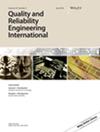Control chart for detecting the scale parameter of the zero‐inflated Poisson model
IF 2.8
3区 工程技术
Q3 ENGINEERING, INDUSTRIAL
引用次数: 0
Abstract
When monitoring risk in public health, count data commonly exhibit an excessive number of zero, and the zero‐inflated Poisson (ZIP) model is often used to fit this type of data. Most previous methods for monitoring of the ZIP model have focused on the changes in the location parameter and the existence of the scale parameter and usually assumed that the scale parameter is zero in the检测零膨胀泊松模型规模参数的控制图
在监测公共卫生风险时,计数数据通常会出现过多的零,零膨胀泊松(ZIP)模型通常用于拟合这类数据。以往对 ZIP 模型的监测方法大多侧重于位置参数的变化和规模参数的存在,通常假设规模参数在 H0 阶段为零。然而,在客观环境中,数据往往具有一定的波动性,这意味着标度参数始终存在。因此,在预定义基线的基础上监测标度参数的变化比监测其是否存在更有意义。在本研究中,我们基于广义亨德森联合似然函数推导出了一个得分检验统计量,并构建了一个风险调整指数加权移动平均(EWMA)控制图来监测 ZIP 混合效应模型中随机效应方差分量的变化。并通过推导证明了得分检验统计量的收敛性,表明新方法具有理论可靠性。仿真结果表明,当尺度参数具有不同的预定义基线和不同的变化幅度时,所提出的方法比现有的 RA-ZIP 和 PR-ZIP 控制图更有效。此外,建议的方法还应用于香港一家医院在线流感监测的真实数据,以证明其实用性。
本文章由计算机程序翻译,如有差异,请以英文原文为准。
求助全文
约1分钟内获得全文
求助全文
来源期刊
CiteScore
4.90
自引率
21.70%
发文量
181
审稿时长
6 months
期刊介绍:
Quality and Reliability Engineering International is a journal devoted to practical engineering aspects of quality and reliability. A refereed technical journal published eight times per year, it covers the development and practical application of existing theoretical methods, research and industrial practices. Articles in the journal will be concerned with case studies, tutorial-type reviews and also with applications of new or well-known theory to the solution of actual quality and reliability problems in engineering.
Papers describing the use of mathematical and statistical tools to solve real life industrial problems are encouraged, provided that the emphasis is placed on practical applications and demonstrated case studies.
The scope of the journal is intended to include components, physics of failure, equipment and systems from the fields of electronic, electrical, mechanical and systems engineering. The areas of communications, aerospace, automotive, railways, shipboard equipment, control engineering and consumer products are all covered by the journal.
Quality and reliability of hardware as well as software are covered. Papers on software engineering and its impact on product quality and reliability are encouraged. The journal will also cover the management of quality and reliability in the engineering industry.
Special issues on a variety of key topics are published every year and contribute to the enhancement of Quality and Reliability Engineering International as a major reference in its field.

 求助内容:
求助内容: 应助结果提醒方式:
应助结果提醒方式:


